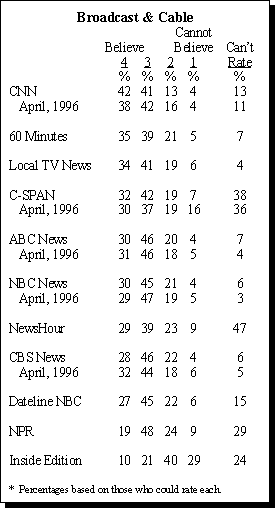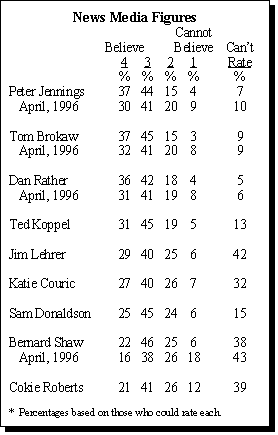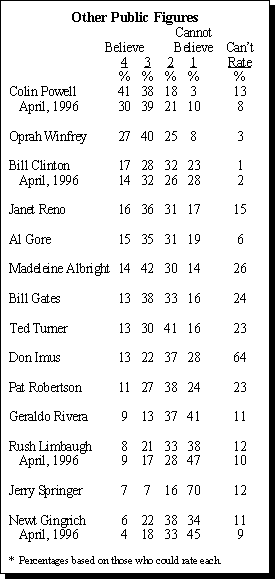Public displeasure with the national news media is clear, but this sentiment has not eroded the credibility of major news organizations. While public evaluations of most news organizations’ credibility are lower than they were in the mid-1980s, the basic believability ratings have not changed since the Center’s last survey in 1996.
 The words people choose to describe the national media reflect their discontent. “Biased” and “sensational” were used nearly as often as “good” and “informative” when survey participants were asked to come up with one word to describe their impression of the national news media. On balance, negative words outnumbered positive ones 52% to 30%.
The words people choose to describe the national media reflect their discontent. “Biased” and “sensational” were used nearly as often as “good” and “informative” when survey participants were asked to come up with one word to describe their impression of the national news media. On balance, negative words outnumbered positive ones 52% to 30%.
In contrast, mostly positive words came to mind when respondents were asked about local news organizations. “Good” is by far the single word most often mentioned, and it is used more than twice as often to describe local news as it is with national news.
Not Liked, But Still Mostly Believed
Displeasure with the national news media in general does not translate, however, into lower believability ratings for specific news organizations. On average, majorities say they can believe most, but not all of what national news organizations say. A fair share of Americans are real doubters, however. Upwards of 20% say they disbelieve much or all of the news delivered by many national news outlets. [NOTE: All ratings based on those who could rate.]
Broadcast news outlets tend to get higher believability ratings than print, a trend evident in earlier surveys. The only exception is at the top of the list, where The Wall Street Journal ties CNN in public esteem. Young people are more likely to give high ratings to cable sources, particularly
CNN and C-SPAN, while older people give especially good ratings to some broadcast news programs, notably 60 Minutes and local TV news.
The public also rates commercial television higher in believability than public broadcasting’s NewsHour and NPR. This pattern reverses itself, however, among college graduates who rate the commercial networks lower and the public broadcasting shows higher.

Americans continue to rate the mainstream media and its personalities higher than most public figures, whose credibility ratings divide along partisan lines. Bill Clinton, Newt Gingrich and Al Gore were given “can’t believe” ratings by at least half of respondents. Secretary of State Madeleine Albright and Attorney General Janet Reno are more highly rated than the President or Vice President. However, former Chairman of the Joint Chiefs of Staff Colin Powell continues to top the list of political figures.

Tabloid and personality oriented outlets are far less credible than mainstream news organizations. Majorities give low believability ratings to People, Inside Edition and the National Enquirer. On balance, even majorities of less well-educated people — who give these sources better than average ratings — say they mostly disbelieve them.

Similarly, talk show hosts Geraldo Rivera, Rush Limbaugh, Pat Robertson and Don Imus achieve far lower ratings than do most news people. Jerry Springer has by far the lowest evaluation in the poll, with 70% of respondents saying they believe nothing of what he says. In sharp contrast, daytime talk-show host Oprah Winfrey is given a believable rating by a majority of those who could evaluate her.



